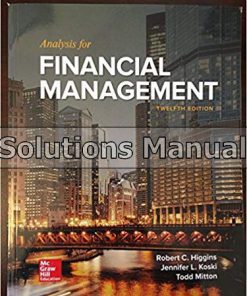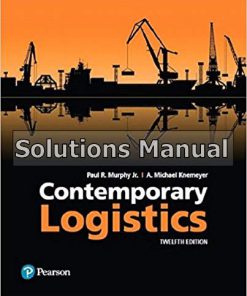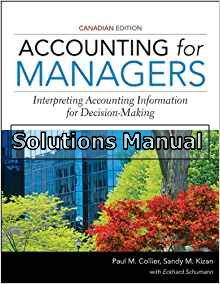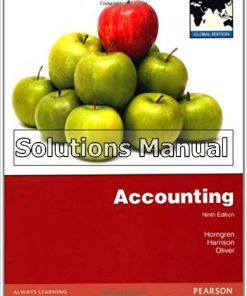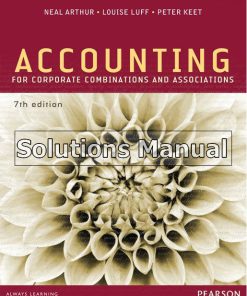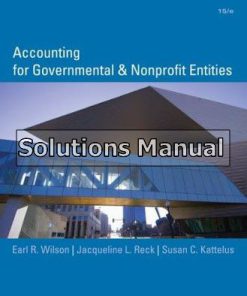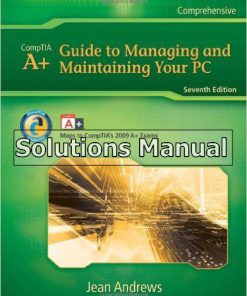Contemporary Financial Management 12th Edition Moyer Solutions Manual
$26.50$50.00 (-47%)
Contemporary Financial Management 12th Edition Moyer Solutions Manual.
You may also like
This is completed downloadable of Contemporary Financial Management 12th Edition Moyer Solutions Manual

Product Details:
- ISBN-10 : 0538479175
- ISBN-13 : 978-0538479172
- Author:
This successful text provides a comprehensive and contemporary introduction to financial management, focusing on shareholder wealth maximization and cash flow management, the international aspects of financial management, the ethical behavior of managers, and the increased impact of the Internet in business practice. Content has been added or enhanced to reflect the effects of the 2008-2009 recessions on corporations.
Table of Content:
- PART 1: Introduction
- Chapter 1: The Role and Objective of Financial Management
- 1-1 Introduction
- 1-2 The Goal of Shareholder Wealth Maximization
- 1-2a Stakeholder Concerns
- 1-2b Divergent Objectives
- 1-2c Agency Problems
- 1-3 Maximization of Shareholder Wealth: Managerial Strategies
- 1-3a Determinants of Value
- 1-3b Managerial Actions to Influence Value
- 1-4 Forms of Business Organization
- 1-4a Sole Proprietorship
- 1-4b Partnership
- 1-4c Corporation
- Ethical Issues: The Practice of Financial Management
- 1-4d Other Types of Business Organizations
- 1-5 Organization of the Financial Management Function
- 1-5a Financial Management and Other Disciplines
- Entrepreneurial Issues: Shareholder Wealth Maximization
- 1-5b Marketing, Production, Quantitative Methods, and Human Resources Management
- 1-6 Career Opportunities in Finance
- 1-7 Professional Finance Affiliations and Certifications
- 1-8 Summary
- 1-9 Questions and Topics for Discussion
- Chapter 2: The Domestic and International Financial Marketplace
- 2-1 Introduction
- 2-2 An Overview of the U.S. Financial System
- 2-2a Financial Assets
- 2-2b Financial Markets
- 2-2c Financial Intermediaries
- 2-3 The Structure and Operation of U.S. Security Markets
- 2-3a Security Exchanges and Stock Market Indexes
- 2-3b Regulation of the Security Markets
- 2-4 The Global Economy and Multinational Enterprises
- 2-5 Foreign Currency Markets and Exchange Rates
- 2-5a The Eurocurrency Market
- 2-5b The Euro: A Common European Currency
- 2-5c Direct and Indirect Quotes
- 2-5d Spot Rates
- 2-5e Forward Rates
- 2-5f Foreign Currency Futures
- 2-5g Foreign Currency Options
- 2-6 Market Efficiency
- 2-6a Information and Capital Market Efficiency
- 2-6b Degrees of Market Efficiency
- 2-6c Implications of Market Efficiency for Financial Managers
- 2-6d Behavioral Finance Perspectives on the Financial Marketplace
- 2-7 Holding Period Returns
- Ethical Issues: Insider Trading
- 2-8 Overview of the Financial Crisis beginning in 2007
- International Issues: Market Efficiency Outside the United States
- 2-8a Causes of the Financial Crisis
- 2-8b How Firms Were Affected by the Financial Crisis
- 2-9 Income Taxes and Financial Management
- 2-9a Implications of Income Taxes for Financial Managers
- 2-9b Tax Rate Used in the Text
- 2-10 Summary
- 2-11 Questions and Topics for Discussion
- 2-12 Self-Test Problems
- 2-13 Problems
- APPENDIX 2A: TAXES
- 2A-1 Introduction
- 2A-2 Corporate Income Taxes
- Entrepreneurial Issues: S Corporations
- 2A-3 Questions and Topics for Discussion
- 2A-4 Self-Test Problems
- 2A-5 Problems
- Chapter 3: Evaluation of Financial Performance
- 3-1 Introduction
- 3-1a Uses of Financial Analysis
- 3-1b Interpreting Financial Ratios
- 3-2 Basic Classifications of Financial Ratios
- 3-2a Key Financial Statements
- 3-2b Liquidity Ratios
- 3-2c Asset Management Ratios
- 3-2d Financial Leverage Management Ratios
- 3-2e Profitability Ratios
- 3-2f Market-Based Ratios
- 3-2g Dividend Policy Ratios
- 3-3 Summary of Financial Ratio Analysis
- 3-4 Trend Analysis
- 3-5 Analysis of Profitability: Return on Investment
- 3-6 Analyzing Profitability Through Return on Stockholders’ Equity
- 3-7 Sources of Comparative Financial Data
- 3-8 A Word of Caution About Financial Ratio Analysis
- 3-9 Earnings and Balance Sheet Quality and Financial Analysis
- 3-9a Earnings Quality
- 3-9b Balance Sheet Quality
- Ethical Issues: The Sarbanes-Oxley Act and the Financial Reporting Process
- 3-10 Market Value Added/Economic Value Added: An Alternative Measure of Performance
- 3-10a The Market Value Added Concept
- 3-10b Economic Value Added
- International Issues: Financial Analysis of Multinational Corporations
- 3-11 Inflation and Financial Statement Analysis
- 3-12 Summary
- 3-13 Questions and Topics for Discussion
- 3-14 Self-Test Problems
- 3-15 Problems
- Chapter 4: Financial Planning and Forecasting
- 4-1 Introduction
- 4-2 Financial Planning
- 4-3 Cash Flow Analysis
- 4-3a The Cash Flow Generation Process
- 4-3b Importance of Cash Flows
- 4-3c Cash Flows and Shareholder Wealth
- 4-3d The Cash Flow Concept
- 4-3e The Statement of Cash Flows
- 4-4 Financial Forecasting
- 4-4a Percentage of Sales Forecasting Method
- 4-4b Cash Budgeting
- 4-4c Pro Forma Statement of Cash Flows
- 4-4d Computerized Financial Forecasting and Planning Models
- 4-4e Using Financial Ratios to Forecast Future Financial Performance
- 4-5 Summary
- 4-6 Questions and Topics for Discussion
- 4-7 Self-Test Problems
- 4-8 Problems
- PART 2: Determinants of Valuation
- Chapter 5: The Time Value of Money
- 5-1 Introduction
- 5-1a A Word About Notation
- 5-1b CFM Excel Templates
- 5-2 The Use of Financial Calculators and Spreadsheets
- 5-2a Calculator Solution
- 5-2b Spreadsheet Solution
- 5-3 Interest
- 5-4 Simple Interest
- 5-5 Compound Interest and Future Value
- 5-5a Solving for the Interest Rate
- 5-5b Solving for the Number of Compounding Periods
- 5-6 Present Value
- 5-6a Solving for Interest and Growth Rates
- 5-7 Annuities
- 5-7a Future Value of an Ordinary Annuity
- 5-7b Future Value of an Annuity Due
- 5-7c Present Value of an Ordinary Annuity
- 5-7d Present Value of an Annuity Due
- 5-8 Present Value: Some Additional Cash Flow Patterns
- 5-8a Perpetuities
- 5-8b Present Value of an Uneven Payment Stream
- 5-8c Present Value of Deferred Annuities
- 5-9 Compounding Periods and Effective Interest Rates
- 5-9a Effect of Compounding Periods on Present and Future Values
- 5-10 Effective Rate Calculations
- 5-11 Net Present Value Rule
- 5-12 Summary
- 5-13 Questions and Topics for Discussion
- 5-14 Self-Test Problems
- 5-15 Problems
- APPENDIX 5A: CONTINUOUS COMPOUNDING AND DISCOUNTING
- 5A-1 Continuous Compounding
- 5A-2 Continuous Discounting
- 5A-3 Effective Rate Calculations
- 5A-4 Self-Test Problems
- 5A-5 Problems
- Chapter 6: Fixed-Income Securities: Characteristics and Valuation
- 6-1 Introduction
- 6-2 Characteristics of Long-Term Debt
- 6-2a Types of Long-Term Debt
- 6-2b Features of Long-Term Debt
- 6-2c Information on Debt Financing Activities
- 6-2d Bond Ratings
- 6-2e Users of Long-Term Debt
- 6-2f Advantages and Disadvantages of Long-Term Debt Financing
- International Issues: The International Bond Market
- 6-3 Valuation of Assets
- 6-3a Capitalization of Cash Flow Method
- 6-3b Market Value of Assets and Market Equilibrium
- 6-3c Book Value of an Asset
- 6-4 Bond Valuation
- 6-4a Bonds Having Finite Maturity Dates
- 6-4b Perpetual Bonds
- Ethical Issues: Leveraged Buyouts and Bond Values
- 6-4c Yield-to-Maturity of a Bond
- 6-5 Characteristics of Preferred Stock
- 6-5a Features of Preferred Stock
- 6-5b Trading of Preferred Shares
- 6-5c Users of Preferred Stock
- 6-5d Advantages and Disadvantages of Preferred Stock Financing
- 6-5e Valuation of Preferred Stock
- 6-6 Summary
- 6-7 Questions and Topics for Discussion
- 6-8 Self-Test Problems
- 6-9 Problems
- Chapter 7: Common Stock: Characteristics, Valuation, and Issuance
- 7-1 Introduction
- 7-1a Understanding Stock Quotations
- 7-2 Characteristics of Common Stock
- 7-2a Common Stock and Accounting
- 7-2b Stockholder Rights
- 7-2c Other Features of Common Stock
- Ethical Issues: Unequal Voting Rights
- 7-2d Advantages and Disadvantages of Common Stock Financing
- 7-3 The Security Offering Process: Role of the Investment Banker
- 7-3a How Securities Are Sold
- 7-4 Valuation of Common Stock
- 7-4a One-Period Dividend Valuation Model
- International Issues: Global Equity Markets
- 7-4b Multiple-Period Dividend Valuation Model
- 7-4c A General Dividend Valuation Model
- 7-5 Applications of the General Dividend Valuation Model
- 7-5a Zero Growth Dividend Valuation Model
- 7-5b Constant Growth Dividend Valuation Model
- 7-5c Nonconstant Growth Dividend Valuation Model
- Entrepreneurial Issues: Valuation of Closely Held Firms
- 7-6 Summary
- 7-7 Questions and Topics for Discussion
- 7-8 Self-Test Problems
- 7-9 Problems
- Chapter 8: Analysis of Risk and Return
- 8-1 Introduction
- 8-2 Meaning and Measurement of Risk
- 8-2a Probability Distributions
- 8-2b Summary of Notation
- 8-2c Expected Value
- 8-2d Standard Deviation: An Absolute Measure of Risk
- 8-2e Normal Probability Distribution
- 8-2f Coefficient of Variation: A Relative Measure of Risk
- 8-2g Risk as an Increasing Function of Time
- 8-3 Relationship Between Risk and Return
- 8-3a Risk-Free Rate of Return
- 8-3b Risk Premium
- 8-3c Business and Financial Risk
- 8-3d Risk and Required Returns for Various Types of Securities
- 8-4 Investment Diversification and Portfolio Risk Analysis
- 8-4a Expected Returns from a Portfolio
- 8-4b Portfolio Risk
- 8-4c Efficient Portfolios and the Capital Market Line
- 8-5 Portfolio Risk and the Capital Asset Pricing Model
- 8-5a Systematic and Unsystematic Risk
- 8-5b Security Market Line (SML
- 8-5c Beta: A Measure of Systematic Risk
- 8-5d Security Market Line and Beta
- 8-5e Inflation and the Security Market Line
- 8-5f Uses of the CAPM and Portfolio Risk Concepts
- International Issues: Diversification and Multinational Corporations
- 8-5g Assumptions and Limitations of the CAPM
- Ethical Issues: High-Risk Securities
- 8-6 Other Dimensions of Risk
- 8-7 Summary
- 8-8 Questions and Topics for Discussion
- 8-9 Self-Test Problems
- 8-10 Problems
- PART 3: The Capital Investment Decision
- Chapter 9: Capital Budgeting and Cash Flow Analysis
- 9-1 Introduction
- 9-2 Key Terms and Concepts in Capital Budgeting
- 9-2a Cost of Capital
- 9-2b How Projects Are Classified
- 9-2c Availability of Funds
- 9-3 Basic Framework for Capital Budgeting
- 9-4 Generating Capital Investment Project Proposals
- 9-4a Classifying Investment Projects
- 9-4b Project Size and the Decision-Making Process
- 9-5 Principles of Estimating Cash Flows
- 9-6 Net Investment (NINV
- 9-7 Net (Operating) Cash Flows
- 9-7a Recovery of After-Tax Salvage Value
- 9-7b Recovery of Net Working Capital
- 9-7c Interest Charges and Net Cash Flows
- 9-7d Depreciation
- 9-8 Asset Expansion Projects
- 9-8a Calculating the Net Investment
- 9-8b Calculating Annual Net Cash Flows
- 9-9 Asset Replacement Projects
- 9-9a Calculating the Net Investment
- 9-9b Calculating Annual Net Cash Flows
- 9-10 Problems in Cash Flow Estimation
- 9-11 The Practice of Cash Flow Estimation for Capital Budgeting
- Ethical Issues: Cash Flow Estimation Biases
- 9-12 Summary
- 9-13 Questions and Topics for Discussion
- 9-14 Self-Test Problems
- 9-15 Problems
- APPENDIX 9A: DEPRECIATION
- 9A-1 Introduction to Depreciation
- 9A-2 Straight-Line Depreciation
- 9A-3 Modified Accelerated Cost Recovery System (MACRS
- 9A-4 Real Property
- 9A-5 Questions and Topics for Discussion
- 9A-6 Problems
- Chapter 10: Capital Budgeting: Decision Criteria and Real Option Considerations
- 10-1 Introduction
- 10-2 Decision Models for Evaluating Alternatives
- 10-2a Net Present Value
- 10-2b Profitability Index
- 10-2c Internal Rate of Return
- 10-2d Payback (PB) Period
- 10-3 Capital Rationing and the Capital Budgeting Decision
- 10-4 Reviewing and Post-Auditing an Accepted Project
- 10-5 A Comprehensive Example of Capital Budgeting: Opening a New Bank Branch
- International Issues: A Framework for International Capital Expenditure Decisions
- 10-6 Real Options in Capital Budgeting
- 10-6a Classification of Real Options in Capital Budgeting
- Ethical Issues: The Use of Shareholder Resources
- 10-6b How Are Real Options Concepts Being Applied
- 10-7 Summary
- 10-8 Questions and Topics for Discussion
- 10-9 Self-Test Problems
- 10-10 Problems
- APPENDIX 10A: MUTUALLY EXCLUSIVE INVESTMENTS HAVING UNEQUAL LIVES
- 10A-1 Replacement Chains
- 10A-2 Equivalent Annual Annuities
- 10A-3 Problems
- Chapter 11: Capital Budgeting and Risk
- 11-1 Introduction
- 11-2 Total Project Risk Versus Portfolio Risk
- 11-3 Adjusting for Total Project Risk
- 11-3a Net Present Value/Payback Approach
- 11-3b Simulation Analysis
- 11-3c Sensitivity Analysis
- 11-3d Scenario Analysis
- 11-3e Certainty Equivalent Approach
- 11-3f Risk-Adjusted Discount Rate Approach
- 11-4 Adjusting for Beta Risk in Capital Budgeting
- 11-4a The All-Equity Case
- International Issues: Special Elements of Capital Budgeting Risk
- 11-4b The Equity and Debt Case
- 11-4c Computing the Risk-Adjusted Net Present Value
- 11-5 Summary
- 11-6 Questions and Topics for Discussion
- 11-7 Self-Test Problems
- 11-8 Problems
- PART 4: The Cost of Capital, Capital Structure, and Dividend Policy
- Chapter 12: The Cost of Capital
- 12-1 Introduction
- 12-2 Summary of Notation
- 12-3 Weighted Cost of Capital
- 12-3a Market Value Versus Book Value Weights
- 12-3b Gasco Inc.’s Weighted Cost of Capital
- 12-3c The Problem of “Lumpy” Capital
- 12-4 Relative Costs of Capital
- 12-5 Computing the Component Costs of Capital
- 12-5a Marginal Costs
- 12-5b Cost of Debt
- 12-5c Cost of Preferred Stock
- 12-5d Cost of Internal Equity Capital
- 12-5e Dividend Valuation Model Approach
- 12-5f Issues in Implementation
- 12-5g Capital Asset Pricing Model (CAPM) Approach
- International Issues: Market Equity Risk Premiums Around the World
- 12-5h Risk Premium over Debt and Other Approaches for Estimating the Cost of Equity Capital
- 12-5i Cost of External Equity Capital
- 12-6 Divisional Costs of Capital
- 12-7 Determining the Weighted (Marginal) Cost of Capital Schedule
- International Issues: The Cost of Capital for Multinational Companies
- 12-8 Determining the Optimal Capital Budget
- Entrepreneurial Issues: The Cost of Capital
- 12-9 Cost of Depreciation-Generated Funds
- 12-10 Summary
- 12-11 Questions and Topics for Discussion
- 12-12 Self-Test Problems
- 12-13 Problems
- Chapter 13: Capital Structure Concepts
- 13-1 Introduction
- 13-2 Capital Structure Decisions and Maximization of Shareholder Wealth
- 13-2a Assumptions of Capital Structure Analysis
- 13-3 Business Risk
- 13-3a Business Risk: Systematic or Unsystematic
- 13-4 Financial Risk and Financial Leverage
- 13-4a Financial Risk: Systematic or Unsystematic
- 13-4b Effect of Financial Leverage on Stockholder Returns and Risk
- 13-5 Capital Structure Theory
- 13-5a Capital Structure Without a Corporate Income Tax
- 13-5b Capital Structure with a Corporate Income Tax
- 13-5c Capital Structure with a Corporate Income Tax: Financial Distress Costs and Agency Costs
- 13-5d Value-Maximizing Capital Structure
- 13-5e The Cost of Capital and the Optimal Capital Structure
- 13-5f Other Considerations in the Capital Structure Decision
- Ethical Issues: LBO Stakeholder Impacts
- International Issues: Capital Structure
- 13-6 Managerial Implications of Capital Structure Theory
- 13-7 Summary
- 13-8 Questions and Topics for Discussion
- 13-9 Self-Test Problems
- 13-10 Problems
- Chapter 14: Capital Structure Management in Practice
- 14-1 Introduction
- 14-2 Operating and Financial Leverage
- 14-2a Leverage and the Income Statement
- 14-2b Short-Run Costs
- 14-2c Long-Run Costs
- 14-2d Measurement of Operating and Financial Leverage
- 14-2e Degree of Operating Leverage
- 14-2f Degree of Financial Leverage
- 14-2g Degree of Combined Leverage
- 14-2h Effect of Leverage on Shareholder Wealth and the Cost of Capital
- 14-3 Other Financial Risk Measures
- 14-4 EBIT-EPS Analysis
- 14-4a EBIT-EPS Analysis and Capital Structure Decisions
- 14-4b EBIT-EPS Analysis and Stock Prices
- 14-5 Cash Insolvency Analysis
- 14-6 Other Factors to Consider in Making Capital Structure Decisions
- 14-6a Industry Standards
- 14-6b Profitability and Need for Funds
- International Issues: Balancing Operating and Financial Risks at Nestl
- 14-6c Lender and Bond-Rater Requirements
- 14-6d Managerial Risk Aversion
- 14-6e Retention of Control
- 14-7 Summary
- 14-8 Questions and Topics for Discussion
- 14-9 Self-Test Problems
- 14-10 Problems
- APPENDIX 14A: BREAKEVEN ANALYSIS
- 14A-1 Introduction
- 14A-2 Graphic Breakeven Analysis
- 14A-3 Algebraic Breakeven Analysis
- 14A-4 Examples of Breakeven Analysis
- 14A-5 DOL and Breakeven Analysis
- 14A-6 Breakeven Analysis and Risk Assessment
- 14A-7 Some Limitations of Breakeven Analysis
- 14A-8 Cash Breakeven Point
- 14A-9 Questions and Topics for Discussion
- 14A-10 Self-Test Problems
- 14A-11 Problems
- Chapter 15: Dividend Policy
- 15-1 Introduction
- 15-2 Determinants of Dividend Policy
- 15-2a Industry and Company Variations in Dividend Payout Ratios
- 15-2b Legal Constraints
- 15-2c Restrictive Covenants
- 15-2d Tax Considerations
- 15-2e Liquidity and Cash Flow Considerations
- 15-2f Borrowing Capacity and Access to the Capital Markets
- 15-2g Earnings Stability
- 15-2h Growth Prospects
- 15-2i Shareholder Preferences
- 15-2j Protection Against Dilution
- 15-3 Dividend Policy and Firm Value
- 15-3a Arguments for the Irrelevance of Dividends
- 15-3b Arguments for the Relevance of Dividends
- 15-3c Transaction Costs
- 15-3d Taxes
- 15-3e Issuance (Flotation) Costs
- 15-3f Agency Costs
- 15-3g Conclusions Regarding Dividend Relevance
- 15-4 Dividend Policies
- 15-4a Passive Residual Policy
- 15-4b Stable Dollar Dividend Policy
- 15-4c Other Dividend Payment Policies
- Entrepreneurial Issues: Dividend Policy
- 15-4d How Dividends Are Paid
- International Issues: Dividend Policies for Multinational Firms
- 15-4e Dividend Reinvestment Plans
- 15-5 Stock Dividends and Stock Splits
- 15-6 Share Repurchases as Dividend Decisions
- 15-6a Procedures for Repurchasing Shares
- 15-6b Share Repurchase Versus Cash Dividend Example
- 15-6c Tax Considerations
- 15-6d Financial Flexibility
- 15-6e Signaling Effects
- 15-6f Earnings-per-Share Dilution
- 15-6g Agency Costs
- 15-6h Advantages and Disadvantages
- 15-7 Summary
- 15-8 Questions and Topics for Discussion
- 15-9 Self-Test Problems
- 15-10 Problems
- PART 5: Working Capital Management
- Chapter 16: Working Capital Policy and Short-Term Financing
- 16-1 Introduction
- 16-2 Working Capital Policy
- 16-2a Importance of Working Capital
- 16-2b Operating Cycle Analysis
- 16-3 Levels of Working Capital Investment
- 16-3a Profitability Versus Risk Trade-Off for Alternative Levels of Working Capital Investment
- 16-3b Optimal Level of Working Capital Investment
- 16-4 Proportions of Short-Term and Long-Term Financing
- 16-4a Cost of Short-Term Versus Long-Term Debt
- 16-4b Risk of Long-Term Versus Short-Term Debt
- 16-5 Profitability Versus Risk Trade-Off for Alternative Financing Plans
- 16-5a Optimal Proportions of Short-Term and Long-Term Debt
- 16-6 Overall Working Capital Policy
- 16-7 Short-Term Credit
- 16-8 Cost of Short-Term Funds
- 16-9 Trade Credit
- 16-9a Credit Terms
- 16-9b Cost of Trade Credit
- 16-9c Stretching Accounts Payable
- 16-10 Accrued Expenses and Deferred Income
- 16-10a Accrued Expenses
- 16-10b Deferred Income
- 16-11 Short-Term Bank Credit
- Ethical Issues: Interest Rate Manipulation
- 16-11a Single Loans (Notes
- 16-11b Lines of Credit
- 16-11c Revolving Credit Agreements
- Ethical Issues: Tying Bank Loans to Other Services
- 16-12 Commercial Paper
- 16-13 Accounts Receivable Loans
- 16-13a Pledging Accounts Receivable
- 16-13b Factoring Accounts Receivable
- 16-14 Inventory Loans
- 16-14a Floating Liens
- 16-14b Trust Receipts
- 16-14c Terminal Warehouse and Field Warehouse Financing Arrangements
- International Issues: Foreign Receivables Financing
- 16-15 Summary
- 16-16 Questions and Topics for Discussion
- 16-17 Self-Test Problems
- 16-18 Problems
- Chapter 17: The Management of Cash and Marketable Securities
- 17-1 Introduction
- 17-2 Liquid Asset Balance
- 17-2a Cash Flows and the Cash Budget
- 17-2b Corporate-Bank Relations
- 17-2c Optimal Liquid Asset Balance
- 17-2d The Practice of Liquidity Management
- 17-3 Controlling the Collection and Disbursement of Cash
- 17-3a Float
- 17-3b Expediting Collections
- 17-3c Slowing Disbursements
- Ethical Issues: Cash Management
- 17-4 Electronic Funds Transfer
- 17-4a Check Clearing for the 21st Century Act
- 17-5 Investing in Marketable Securities
- 17-5a Choosing Marketable Securities
- Entrepreneurial Issues: Cash Management
- 17-5b Types of Marketable Securities
- International Issues: Cash Management
- 17-6 Summary
- 17-7 Questions and Topics for Discussion
- 17-8 Self-Test Problems
- 17-9 Problems
- Chapter 18: The Management of Accounts Receivable and Inventories
- 18-1 Introduction
- 18-2 Accounts Receivable Management
- 18-2a Shareholder Wealth and Optimal Investments in Accounts Receivable
- 18-2b Credit Standards
- 18-2c Credit Terms
- 18-2d Collection Effort
- 18-2e Monitoring Accounts Receivable
- 18-3 Evaluating Individual Credit Applicants
- 18-3a Gathering Information on the Credit Applicant
- 18-3b Analyzing Creditworthiness and Making the Credit Decision
- 18-4 Inventory Management
- 18-4a Benefits of Holding Inventories
- 18-4b Inventory-Related Costs
- 18-5 Inventory Control Models
- 18-5a Basic EOQ Model
- 18-5b Extensions of the Basic EOQ Model
- 18-5c Just-in-Time Inventory Management Systems
- 18-6 Summary
- 18-7 Questions and Topics for Discussion
- 18-8 Self-Test Problems
- 18-9 Problems
- PART 6: Additional Topics in Contemporary Financial Management
- Chapter 19: Lease and Intermediate-Term Financing
- 19-1 Introduction
- 19-2 Leasing
- 19-3 Types of Leases
- 19-3a Operating Leases
- 19-3b Financial or Capital Leases
- 19-3c Leveraged Leases
- 19-4 Advantages and Disadvantages of Leasing
- 19-4a Advantages
- Entrepreneurial Issues: Leasing by Small Businessesa
- 19-4b Disadvantages
- 19-5 Tax and Accounting Aspects of Leases
- 19-5a Tax Status of True Leases
- 19-5b Leases and Accounting Practices
- 19-6 Determining Lease Payments: The Lessor’s Perspective
- 19-7 Lease-Buy Analysis: The Lessee’s Perspective
- 19-8 Term Loans
- 19-8a Repayment Provisions
- 19-8b Interest Costs
- 19-9 Security Provisions and Protective Covenants
- 19-9a Security Provisions
- 19-9b Affirmative Covenants
- 19-9c Negative Covenants
- 19-9d Restrictive Covenants
- 19-9e Default Provisions
- 19-10 Suppliers of Term Loans
- 19-10a Commercial Banks and Savings and Loan Associations
- 19-10b Life Insurance Companies and Pension Funds
- 19-10c Small Business Administration (SBA
- 19-10d Small Business Investment Companies (SBICs
- 19-10e Industrial Development Authorities (IDAs
- 19-11 Equipment Loans
- 19-11a Conditional Sales Contract
- 19-11b Chattel Mortgage
- 19-12 Summary
- 19-13 Questions and Topics for Discussion
- 19-14 Self-Test Problems
- 19-15 Problems
- Chapter 20: Financing with Derivatives
- 20-1 Introduction
- 20-2 Options
- 20-2a Option Valuation Concepts
- 20-2b Variables Affecting Call Option Valuation
- 20-2c Option Valuation Models
- 20-2d Call Options on Bonds
- 20-2e Common Stock in an Options Framework
- 20-3 Convertible Securities
- 20-3a Features of Convertible Securities
- 20-3b Managing Long-Term Funding with Convertibles
- 20-3c Valuation of Convertible Securities
- 20-3d Converting Convertible Securities
- 20-3e Convertible Securities and Earnings Dilution
- 20-4 Warrants
- 20-4a Features of Warrants
- 20-4b Reasons for Issuing Warrants
- 20-4c Valuation of Warrants
- 20-4d Comparison of Convertible Securities and Warrants
- 20-5 Analysis of Rights Offerings
- 20-5a Valuation of Rights
- 20-6 Swaps
- 20-6a Interest Rate Swaps
- 20-6b Credit Default Swaps
- 20-7 Summary
- 20-7a Options
- 20-7b Convertible Securities
- 20-7c Warrants
- 20-7d Rights Offering
- 20-7e Swaps
- 20-8 Questions and Topics for Discussion
- 20-9 Self-Test Problems
- 20-10 Problems
- APPENDIX 20A: THE BLACK-SCHOLES OPTION PRICING MODEL
- 20A-1 The Foundations of Option Valuation
- 20A-2 The Black-Scholes Option Pricing Model
- 20A-3 Applying the Black-Scholes Model
- 20A-4 Problems
- APPENDIX 20B: BOND REFUNDING ANALYSIS
- 20B-1 The Bond Refunding Process
- 20B-2 Problems
- Chapter 21: Risk Management
- 21-1 Introduction
- 21-2 Why Manage Risk
- 21-3 Nonhedging Risk-Management Strategies
- 21-3a Acquisition of Additional Information
- 21-3b Diversification
- 21-3c Insurance
- 21-3d Gaining Control over the Operating Environment
- 21-3e Limited Use of Firm-Specific Assets
- 21-4 Hedging Strategies for Risk Management
- 21-4a Forward Contracts
- 21-4b Futures Contracts
- 21-4c A Long Hedge
- 21-4d A Short Hedge
- 21-5 Hedging Price Risk with Options
- 21-5a Final Comments Regarding Risk-Management Strategies
- Ethical Issues: AIG, the Financial Crisis of 2008, and the Failure of Risk Management
- 21-6 Summary
- 21-7 Questions and Topics for Discussion
- 21-8 Self-Test Problems
- 21-9 Problems
- Chapter 22: International Financial Management
- 22-1 Introduction
- 22-2 Factors That Affect Exchange Rates
- 22-2a Covered Interest Arbitrage and Interest Rate Parity
- 22-2b Purchasing Power Parity
- 22-2c Expectations Theory and Forward Exchange Rates
- 22-2d The International Fisher Effect
- 22-2e An Integrative Look at International Parity Relationships
- 22-3 Forecasting Future Exchange Rates
- 22-3a Using Forward Rates
- 22-3b Using Interest Rates
- 22-4 Foreign Exchange Risk
- 22-4a Transaction Exposure
- 22-4b Economic Exposure
- 22-4c Translation Exposure
- Ethical Issues: Payment of Bribes Abroad
- 22-5 Summary
- 22-6 Questions and Topics for Discussion
- 22-7 Self-Test Problems
- 22-8 Problems
- Chapter 23: Corporate Restructuring
- 23-1 Introduction
- 23-2 Mergers and Acquisitions
- 23-2a Mergers Defined
- 23-2b Merger Statistics
- 23-2c Types of Mergers
- 23-2d Form of Merger Transactions
- 23-2e Holding Companies
- 23-2f Joint Ventures
- 23-2g Leveraged Buyouts
- 23-2h Divestitures and Restructurings
- 23-2i Tender Offers
- 23-2j Rationale for Restructuring
- 23-2k Antitakeover Measures
- 23-2l Reasons for Mergers
- 23-2m Accounting Aspects of Mergers
- 23-2n Tax Aspects of Mergers
- 23-2o Valuation of Merger Candidates
- 23-2p Valuation Techniques
- 23-2q Analysis of a Merger: Earnings per Share and P/E Effects
- 23-3 Business Failure
- 23-3a Definitions of Business Failure
- 23-3b Business Failure Statistics
- 23-3c Causes of Business Failure
- 23-3d Alternatives for Failing Businesses
- 23-3e Informal Alternatives for Failing Businesses
- 23-3f Formal Alternatives for Failing Businesses Under the Bankruptcy Laws
- 23-3g Reorganization
- 23-3h Liquidation
- 23-4 Summary
- 23-5 Questions and Topics for Discussion
- 23-6 Self-Test Problems
- 23-7 Problems
- Reference Materials Tables
- Glossary
- Solutions to Self-Test Problems
- Check Answers to Selected Problems
- Index
People Also Search:
contemporary financial management moyer
contemporary financial management 12th edition moyer
contemporary financial management
contemporary financial management 12th edition
contemporary financial management 12th edition solution manual download pdf
contemporary financial management 12th edition download scribd

